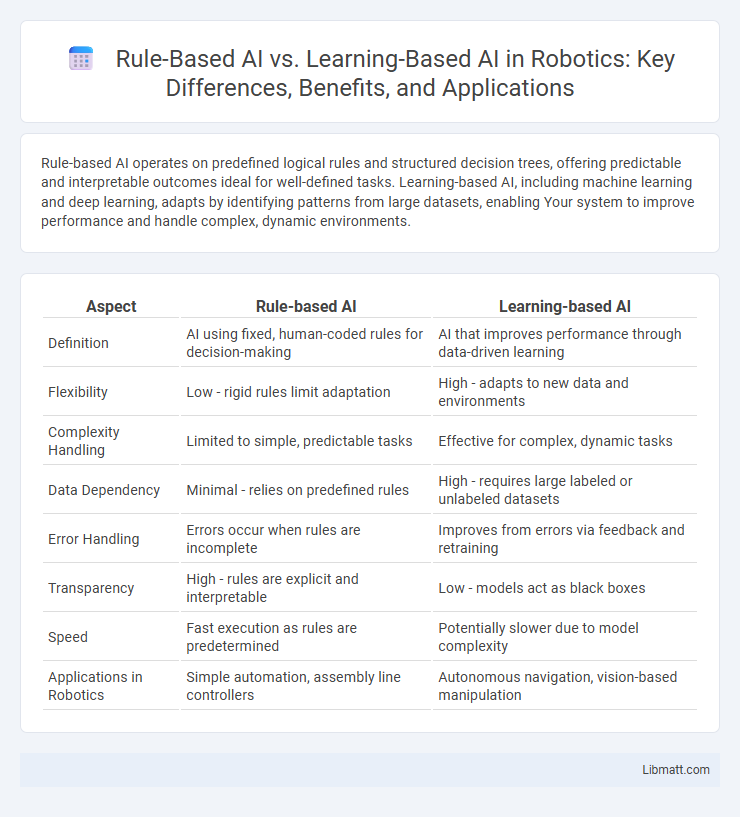Rule-based AI operates on predefined logical rules and structured decision trees, offering predictable and interpretable outcomes ideal for well-defined tasks. Learning-based AI, including machine learning and deep learning, adapts by identifying patterns from large datasets, enabling Your system to improve performance and handle complex, dynamic environments.
Table of Comparison
| Aspect | Rule-based AI | Learning-based AI |
|---|---|---|
| Definition | AI using fixed, human-coded rules for decision-making | AI that improves performance through data-driven learning |
| Flexibility | Low - rigid rules limit adaptation | High - adapts to new data and environments |
| Complexity Handling | Limited to simple, predictable tasks | Effective for complex, dynamic tasks |
| Data Dependency | Minimal - relies on predefined rules | High - requires large labeled or unlabeled datasets |
| Error Handling | Errors occur when rules are incomplete | Improves from errors via feedback and retraining |
| Transparency | High - rules are explicit and interpretable | Low - models act as black boxes |
| Speed | Fast execution as rules are predetermined | Potentially slower due to model complexity |
| Applications in Robotics | Simple automation, assembly line controllers | Autonomous navigation, vision-based manipulation |
Introduction to Rule-based and Learning-based AI
Rule-based AI relies on predefined logical rules and expert knowledge to make decisions, enabling precise control and interpretability. Learning-based AI utilizes algorithms, such as neural networks and reinforcement learning, to identify patterns and improve performance from data, allowing adaptability in complex environments. These foundational approaches represent distinct paradigms in artificial intelligence development with varied applications across industries.
Defining Rule-based AI: Concepts and Mechanisms
Rule-based AI operates through predefined sets of explicit rules and logic to make decisions and solve problems, relying on human-crafted if-then statements. This form of AI excels in environments with clear, structured knowledge, providing predictable and explainable outputs without adapting to new data. Your understanding of rule-based AI highlights its deterministic nature, contrasting with the adaptive, data-driven processes found in learning-based AI.
Learning-based AI: Principles and Techniques
Learning-based AI relies on algorithms that enable systems to improve performance through data exposure without explicit programming. Key techniques include supervised learning, where models are trained on labeled datasets, unsupervised learning for discovering hidden patterns, and reinforcement learning that optimizes decision-making through feedback loops. Neural networks and deep learning architectures play a crucial role in enabling complex pattern recognition and adaptation in learning-based AI systems.
Key Differences Between Rule-based and Learning-based AI
Rule-based AI operates on predefined sets of explicit rules, enabling predictable and transparent decision-making processes ideal for well-structured tasks. Learning-based AI, such as deep learning and neural networks, relies on data-driven training to identify patterns and improve performance over time without human-coded instructions. The core difference lies in flexibility and adaptability: rule-based systems excel in stable environments with clear guidelines, while learning-based AI thrives in complex, dynamic contexts requiring continuous learning from data.
Advantages of Rule-based AI Systems
Rule-based AI systems offer high transparency and predictability, making it easier to understand and debug their decision-making processes. They provide consistent and reliable performance in well-defined domains with clearly established rules. These systems require less data for implementation compared to learning-based AI, enabling faster deployment and lower computational costs.
Benefits of Learning-based AI Approaches
Learning-based AI approaches offer superior adaptability by continuously improving from data, enabling more accurate predictions and personalized user experiences. Your systems benefit from enhanced scalability and the ability to handle complex, unstructured information without requiring exhaustive rule definitions. These advantages make learning-based AI essential for dynamic environments where evolving patterns and behaviors demand flexible, data-driven solutions.
Common Applications of Rule-based AI
Rule-based AI is commonly applied in expert systems, automated customer support, and fraud detection where predefined rules guide decision-making. Industries such as healthcare use rule-based AI for diagnostic support by encoding medical knowledge into explicit rules. In finance, rule-based systems monitor transactions in real-time to identify suspicious activities based on established regulatory criteria.
Use Cases for Learning-based AI
Learning-based AI excels in dynamic environments such as natural language processing, image recognition, and autonomous driving, where it adapts and improves from vast datasets. Your business can leverage learning-based AI for personalized recommendations, fraud detection, and predictive maintenance, enabling continuous optimization and decision-making. Its capability to identify complex patterns makes it indispensable in healthcare diagnostics and customer sentiment analysis.
Limitations and Challenges: Rule-based vs Learning-based AI
Rule-based AI struggles with scalability and adaptability due to its reliance on predefined rules, limiting its ability to handle complex, unstructured data or evolving scenarios. Learning-based AI faces challenges such as requiring large amounts of quality data, risk of overfitting, and interpretability issues, which can hinder trust and transparency. Your choice between the two depends on the specific problem domain, data availability, and need for model flexibility versus explainability.
Future Trends in AI: Rule-based vs Learning-based Approaches
Future trends in AI indicate a growing integration of rule-based and learning-based approaches to enhance system robustness and adaptability. Rule-based AI excels in scenarios requiring explicit, interpretable knowledge representation, while learning-based AI, powered by deep learning and reinforcement learning, continues to advance in autonomous decision-making and pattern recognition. Hybrid models combining symbolic reasoning with neural networks are emerging as a prominent solution to address the limitations of each method, driving innovation in explainable AI and real-world applications.
Rule-based AI vs Learning-based AI Infographic

 libmatt.com
libmatt.com